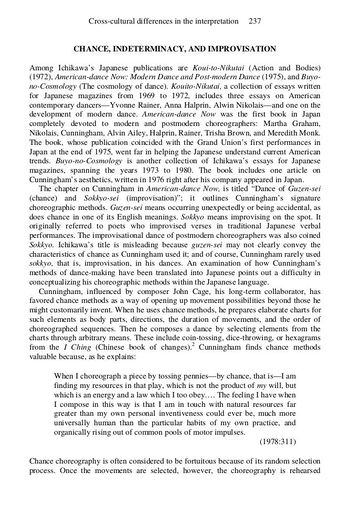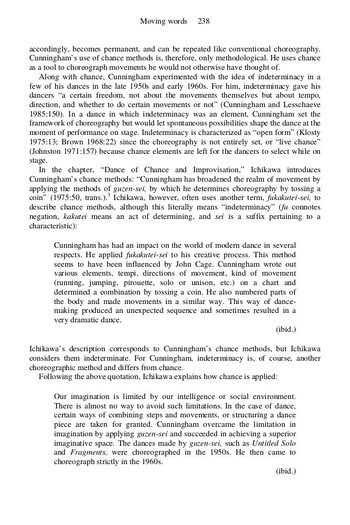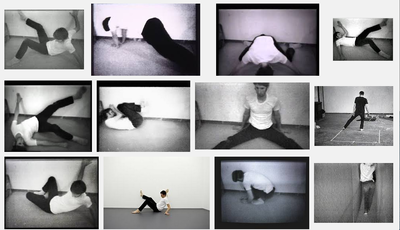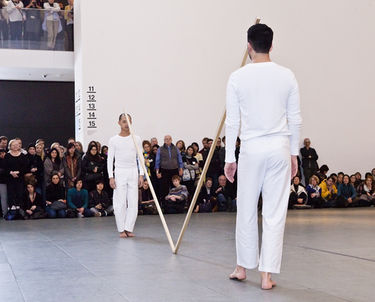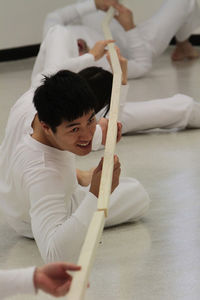Final Presentation V2: Difference between revisions
No edit summary |
No edit summary |
||
| Line 43: | Line 43: | ||
[[File:1.trishabrown.jpg|375px|1]] | [[File:1.trishabrown.jpg|375px|1]] | ||
[[File:49048.jpg|200px|2]] | [[File:49048.jpg|200px|2]] | ||
<small>draft text for exhibit: | |||
Cross-disciplinary media objects that share time and space, with subjects, in relational encounters. | |||
The encyclopaedia of movement in space proposes a series of constructed situations, a new stage for a lived experience of corporeality, in which the viewer, now the performer, acquires a different consciousness of the space we are in. | |||
“Since we’re no longer restricted to the prescribed classical methods of connection, we’re open to an extraordinary leap in connection, which is just a matter of defining connective space." - William Forsythe. | |||
"Dancing it specifies its contact with the ground, which remains the fragile of its stay in world. There is no ground beneath the ground, because every reality is a kind of floating architecture stretched above the abyss of botyomlessness. Dance articulates this knowledge about this uncertainty bu recognizing the reality of the subject as unfolded reality. It implies and re.actualises the ontological vagueness of human existence. This is what its ease is based on: on the affirmation of the indifinite, which marks the absence of origin of the subjectc and the certainty that nothing is certain in relation to its future, which remains contingent and vague..." Marcus Steinweg on Dance. | |||
Body, the physical self. “That knowledge-acquiring apparatus." - Merleau Ponty (at Phemenology of Perception) | |||
Choreographic Objects, a collection of three different choreographic approaches from three performance artists. | |||
ONE | |||
Merce Cunningham - Chance Operations. | |||
(game piece structure + scores/ navigational instruments/short instructions: sequence of actions and re-orientation / trajectory) | |||
TWO | |||
Bruce Nauman - Wall-Floor Positions | |||
(individual/solo improvisation) | |||
THREE | |||
Trisha Brown - Sticks | |||
(collective improvisation + conducting) | |||
</small> | |||
Revision as of 11:57, 16 June 2015
Motion in Space: “constructed situations” (three hypothesis)
Since we’re no longer restricted to the prescribed classical methods of connection, we’re open to an extraordinary leap in connection, which is just a matter of defining connective space. - William Forsythe.
"Phenomenological Vector", also about the nature of connection, "the body as the pre-objective ground for all experience of the relatedness of objects is the first "world" explored" by Phemenology of Perception - Merleau Ponty
The art object times and it spaces. This is one of the consequences of the object-oriented approach. As Tim Morton puts it, “If there is no top object [overmining] and no bottom object [undermining], neither is there a middle object. That is, there is no such thing as a space, or time, “in” which objects float. There is no environment distinct from objects. [….] Objects don’t sit in a box of space or time. It’s the other way around: space and time emanate from objects.” Because object-oriented philosophy holds that any relation between any two objects automatically produces distortion all objects relating are generative entities. Relationships create differences. My distorting of the original is to be expected, according to the object-oriented thinking all translations are “lossy” and this loss or distortion in the translation from one object relating to another is at the core of performance art. Object-Oriented Philosophy and Performance Art, by Paul Boshears
ONE
Merce Cunningham
Chance Operations.
TWO
Bruce Nauman
Wall-Floor Positions, 1968, 60 min, b&w, sound
In this videotape Nauman assumes a set of positions in relation to a wall and floor similar to those he had executed for an untitled 1965 performance, which he described as "standing with my back to the wall for about forty-five seconds or a minute, leaning out from the wall, then bending at the waist, squatting, sitting, and finally lying down. There were seven different positions in relation to the wall and floor. Then I did the whole sequence again standing away from the wall, facing the wall, then facing left and right. There were twenty-eight positions and the whole presentation lasted an hour."
THREE
Trisha Brown
Length: 3-10 minutes Original cast: Trisha Brown, Elizabeth Garren, Terry O'Reilly, Steve Paxton, Wendy Perron, Judith Ragir, Mona Sulzman
A 10-foot-long, ¾” x ¾” stick is placed with one end against the base of the wall and the other end on the dancer’s head. The dancer facing the wall moves forward maintaining the original angle of the stick until the head is wedged in between the stick and the floor. Performed by four dancers placed at equal distances along one wall or in partners – stick against stick – in the center of the gallery.
draft text for exhibit:
Cross-disciplinary media objects that share time and space, with subjects, in relational encounters.
The encyclopaedia of movement in space proposes a series of constructed situations, a new stage for a lived experience of corporeality, in which the viewer, now the performer, acquires a different consciousness of the space we are in.
“Since we’re no longer restricted to the prescribed classical methods of connection, we’re open to an extraordinary leap in connection, which is just a matter of defining connective space." - William Forsythe.
"Dancing it specifies its contact with the ground, which remains the fragile of its stay in world. There is no ground beneath the ground, because every reality is a kind of floating architecture stretched above the abyss of botyomlessness. Dance articulates this knowledge about this uncertainty bu recognizing the reality of the subject as unfolded reality. It implies and re.actualises the ontological vagueness of human existence. This is what its ease is based on: on the affirmation of the indifinite, which marks the absence of origin of the subjectc and the certainty that nothing is certain in relation to its future, which remains contingent and vague..." Marcus Steinweg on Dance.
Body, the physical self. “That knowledge-acquiring apparatus." - Merleau Ponty (at Phemenology of Perception)
Choreographic Objects, a collection of three different choreographic approaches from three performance artists.
ONE
Merce Cunningham - Chance Operations.
(game piece structure + scores/ navigational instruments/short instructions: sequence of actions and re-orientation / trajectory)
TWO
Bruce Nauman - Wall-Floor Positions
(individual/solo improvisation)
THREE
Trisha Brown - Sticks
(collective improvisation + conducting)

